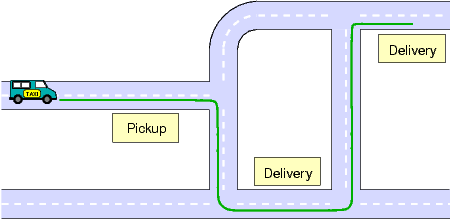Dial-a-Ride Problem and Demand Responsive Transport
Demand responsive transport (DRT) refers to an advanced public transport mode, where vehicles (e.g., mini-vans) are routed according to customers' trip request without any predefined schedules. The corresponding dynamic optimization problem is known as the dial-a-ride problem:
|

Figure: A single vehicle in a dial-a-ride problem. |
Our publications
Some other references:
- Paolo Toth and Daniele Vigo, The Vehicle Routing Problem, SIAM, 2001.
- H.N. Psaraftis, Dynamic Vehicle Routing Problems, in Vehicle Routing: Methods and Studies, pp. 223-248, B.L. Golden and A.A. Assad eds., North Holland, 1988.
- Jean-François Cordeau and Gilbert Laporte, The dial-a-ride problem: models and algorithms, Annals of Operations Research, vol. 153, no. 1, pp. 29-46, Springer, September 2007.
- G. Berbeglia and J.-F. Cordeau and G. Laporte, Dynamic Pickup and Delivery Problems, European Journal of Operational Research, vol. 202, no.1, pp. 8-15, Elsevier, April 2010.
